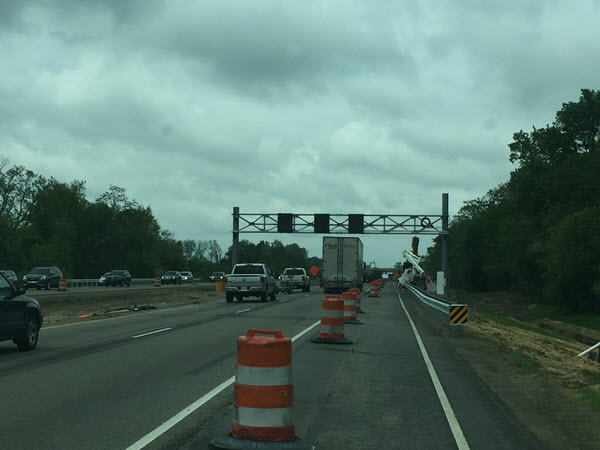Michigan DOT no topic June 2017
Michigan DOT sent this bulletin at 06/09/2017 01:54 PM EDT |
|
Having trouble viewing this email? View it as a Web page. |
June 2017
The inner workings of MDOT's new Flex Route system

|
|
Prior to onsite installation, mockup testing of the lane display boards was completed in early April. |
Later this year, motorists will drive through a safer and more efficient roadway along the US-23 corridor when Michigan introduces its first Flex Route, which will be located between M-14, north of Ann Arbor, and M-36 in Northfield Township.
MDOT system engineers recently held an internal demonstration to show how the network of signs, cameras, and electronic message boards, which are all mounted onto overhead gantries, will interact collectively to monitor traffic conditions and alert motorists as to any travel-related issues ahead.
The demo included seeing the huge 5-foot-by-6-foot LED signs that will be mounted on overhead gantries, the highly secure IT cabinets that will collect and distribute pertinent communications, and a close-up look at how operators will be continually observing monitors in order to analyze the current traffic conditions and, when needed, to manage the flex lanes.
"There are several components that are inherent in the design of this smart road technology," said Jennifer Foley, MDOT Traffic and Operations engineer. "Of course, it is imperative that all switches and devices are online and communicating in order to make it all happen."
The Flex Route system will be controlled from the Lansing Statewide Transportation Operations Center (STOC), located in the Van Wagoner Transportation Building, where the data will be collected from high-tech sensors and video cameras.
The Flex Route system will constantly monitor the traffic speed of each open lane to identify any slowdown that might be caused by a traffic incident and/or congestion ahead. Whenever this occurs, the system will quickly post an appropriate warning to alert motorists and recommend the current safest speed limit. Motorists will see this information posted on the huge overhead signs. STOC operators will continue to scrutinize the real-time video images on their monitors, and take the appropriate actions to close or open the shoulder lane to traffic.
The flex lanes (or shoulders) will be closed when traffic is light and there are no incidents. However, if a traffic sensor detects travel speeds slowing in open lanes, specific protocols may be put into action. For example:
- In the event of a traffic slowdown, sensors monitoring speed data might trigger an alert to the operator, who then will visually confirm if the current traffic flow meets the established criteria for opening the flex lane. If it does, the shoulder will be opened to relieve congestion and improve travel, and the STOC operators will change the red "X" (that had indicated a closed lane) to a green arrow to show motorists the flex lane is now open.
- If a traffic incident occurs, the emergency notification process will be immediately triggered. Once operators have verified the incident on screen, they will alert first responders. Motorists within a mile of the event will begin to see pre-programmed messages appear on the overhead gantries, which will guide them around the incident. A yellow chevron/merge sign will direct them to move over so they can avoid the incident. Another sign will post the current recommended speed limit. As motorists move closer to the incident, the overhead sign will have a red “X” above each lane that is blocked. Once operators have received notice from first responders that the incident has been cleared, they will confirm this on their monitors, and then change the signage accordingly.
 |
| Installation of gantries along northbound US-23. In addition to the gantries, three large dynamic messaging signs (DMS) are being installed. |
The Flex Route system, which is designed to address multiple events, will be tested repeatedly as MDOT engineers continue to adjust the software program to handle various scenarios. All system components will undergo a rigorous testing period prior to opening the Flex Route.
Launching the Flex Route will mark the beginning of a new era in smart road technology for Michigan. Motorists are encouraged to familiarize themselves with how a Flex Route works by viewing this short video.
If you have any questions concerning the Flex Route, contact the Brighton TSC at 810-227-4681. For more information about related traffic detours, lane closures and lane shifts, go to www.flexroute23.com or connect with MDOT through social media at www.facebook.com/michigandot and www.twitter.com/mdot_a2, search using #flexroute.
Current and upcoming construction activities(See map)
Mainline US-23:

|
|
South of North Territorial Road, the Flex Route lane is beginning to take shape. The concrete base course has been placed and additional courses continue to be placed nightly. |
- Between 8 Mile Road and M-36: Embankment and sand sub-base are being placed along the outside shoulder of southbound US-23 between 8 Mile Road and M-36.
- Barker Road to 8 Mile Road: Within these limits, two lanes of northbound and two lanes of southbound traffic have been placed on the northbound roadway and the existing southbound lanes are being fully reconstructed along with the Great Lakes Central Railroad bridge and repairs of the Barker Road bridge. Once complete, all traffic will be shifted to the newly constructed southbound lanes and the northbound lanes will be fully reconstructed. This shift is anticipated to take place in mid to late August.
Interchanges:
- North Territorial Road: The new bridge deck is poured. Curb and gutter for the ramps and new roundabouts are scheduled for the week of June 5. Paving will follow within three days of curb placement. It is estimated the interchange will be opened by June 15.
-
6 Mile Road: Full closure of this roadway is scheduled to follow the opening of North Territorial Road. Tentatively scheduled for June 15.

|
|
Roundabout paving at the 8 Mile Road on and off ramps. |
- 8 Mile Road: The new 8 Mile Road was built from the alignment of the existing roadway. Tie-in of the new roadway to the existing roadway requires various closures on both the east and west side of the interchange. All tie-in work is scheduled to be complete by June 14, at which time 8 Mile Road and Whitmore Lake Road will utilize the new roundabouts and new roadway.
Frequently Asked Questions (FAQ)
How do they know what's down the road?
Trained operators in MDOT's STOC will use traffic sensors and real-time video images to monitor travel conditions. This data will enable them to identify any slowdowns, traffic incidents and/or lane blockages ahead.
How will they know when to open a shoulder (flex lane) to motorists?
STOC operators will respond in real time to current travel conditions. For example, when traffic slows to speeds pre-established in guidelines, operators will open or close lanes accordingly. They also will post appropriate safety information to guide motorists, such as lane blockages ahead and recommended speed limits for existing conditions.
For more details, view the Flex Route 23 brochure.
